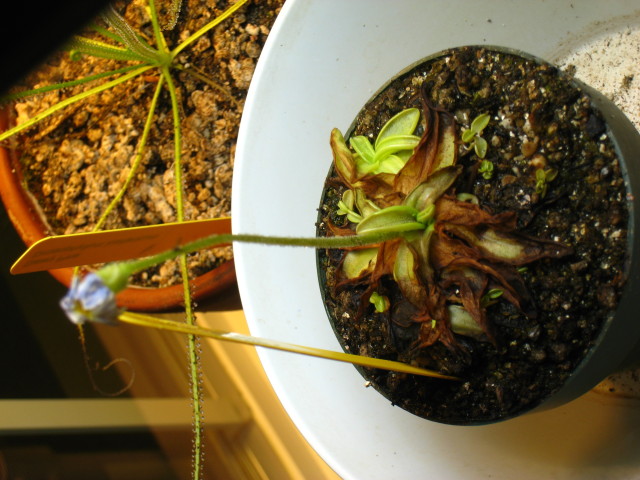Question Ailing P. Primuliflora
Ailing P. Primuliflora
QUESTION: I purchased a primrose butterwort at your open house a few weeks ago. It
doesn't appear to be doing well. I realize that this is a somewhat difficult
plant to grow, but I'm hoping that it's not too late to turn it around. When I
purchased the plant, it was flowering. The flower is now dying, but I suppose
that could just be its normal course. However, the plant is losing a lot of
leaves; they're turning brown and disintegrating. I have the plant on a shelf
right next to a south-facing window. Also, I have a compact fluorescent bulb
above it, running on a 12-hour timer. The bulb fixture probably shades the
plant from most direct sun coming through the window. I've been keeping
the soil watered but not to the extent where there is much standing water in
the tray. Do you have any advice? Would it be worthwhile to repot into a
larger flower pot? perhaps a self-watering pot? Might it do better outdoors?
Should I spray it with sulfur fungicide? Orchid fertilizer? I'd really like to save
this plant. Any suggestions would be appreciated. Thank you.
ANSWER: Hi Robert,
Thank you for the photo. That helps a lot. There might be two issues going on. One is fungus, but usually you will see it on the leaves. With the rapid deterioration of the flower, I suspect you soil might have fungus gnat larvae. Check the soil very closely. If you see tiny worms moving through the soil, they might be the culprit. They will eat the plant's roots, which will cause the symptoms you're currently seeing.
To be sure, I also checked our current stock, and all of the plants are growing quite well. Fungus gnats is a very common pest in many homes, and the moist soil of carnivorous plants will often attract these critters. (I see the Drosophyllum in the background. That plant should be safe from fungus gnats since that soil is usually much drier and courser.)
To get rid of them, spray the plant and soil with an insecticide containing pyrethrin. You can also use a systemic insecticide. Watch our video podcast on insecticides for more information:
http://www.cobraplant.com/videos
Good growing!
Jacob Farin
---------- FOLLOW-UP ----------
QUESTION: Thanks Jacob. I definitely would not have thought of that. Close by this plant
(but not within the view of the photo) I have the rest of my indoor carnivorous
plant collection. Many of these have established populations of fungus gnats,
which must have colonized the new butterwort. The gnat larvae don't seem to
be causing problems with any of the other plants, and I have always
considered the gnats to be a beneficial source of prey for the tropical
sundews and Mexican butterworts. I took a look at the butterwort soil under
some magnification and didn't see any larvae; I did see one reddish mite
crawling around. Nonetheless, I treated the plant with insecticide. I don't
currently have any of the systemic, permethrin-, or pyrethrin-based
insecticides recommended in the video (I'll have to buy those), but I do have a
neem-oil-based spray, so I used that. Hopefully it's not too late for the plant
to make a comeback. Thanks again.
AnswerYes, Neem will work too. You should also treat the other plants as well. While the adults might be food for your plants, your plants might be food for the larvae! The larvae will munch the roots and stunt growth.
I did see that one of the butterworts in the pot looked relatively healthy. You could always separate this plant out and start your colony anew.






